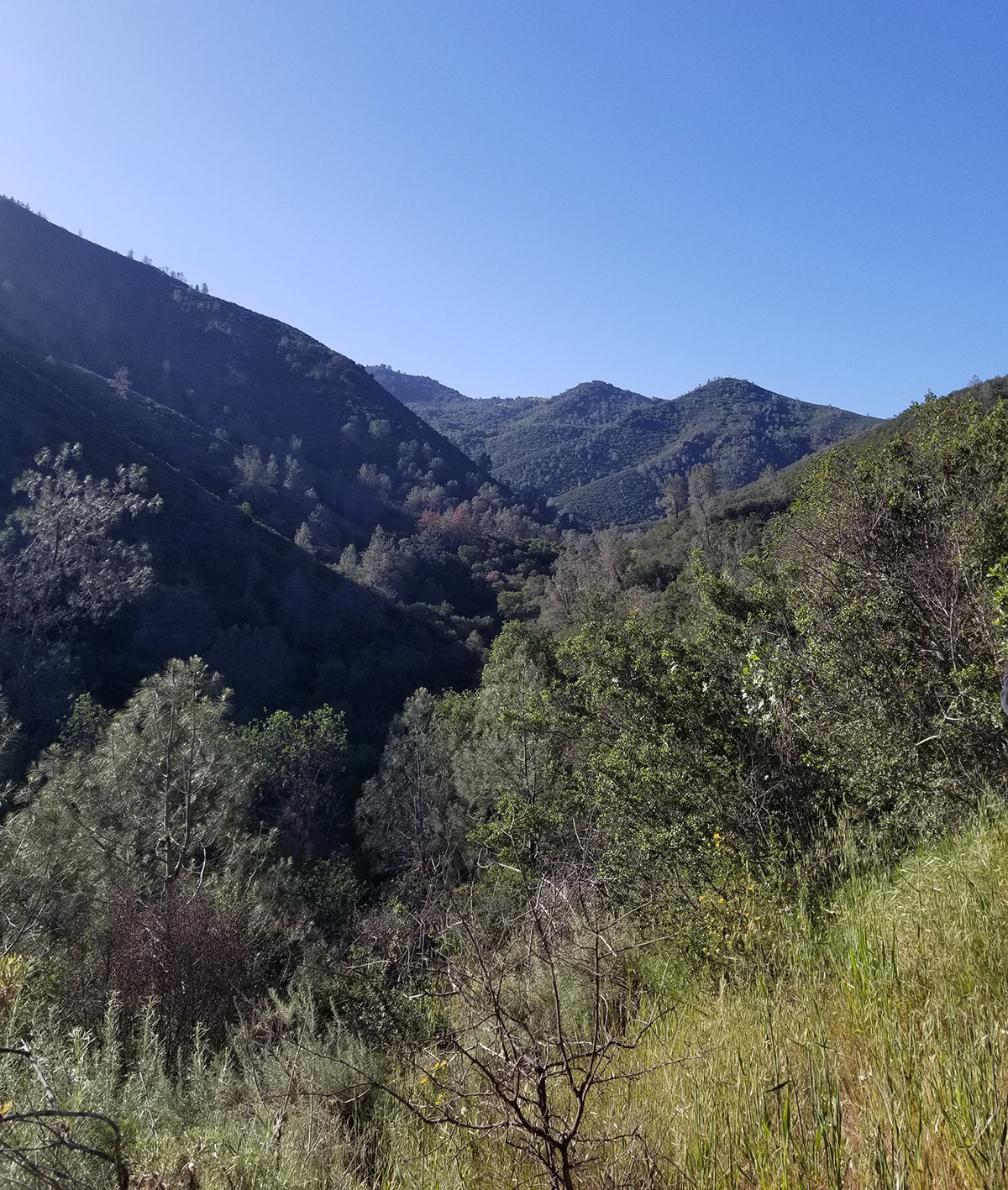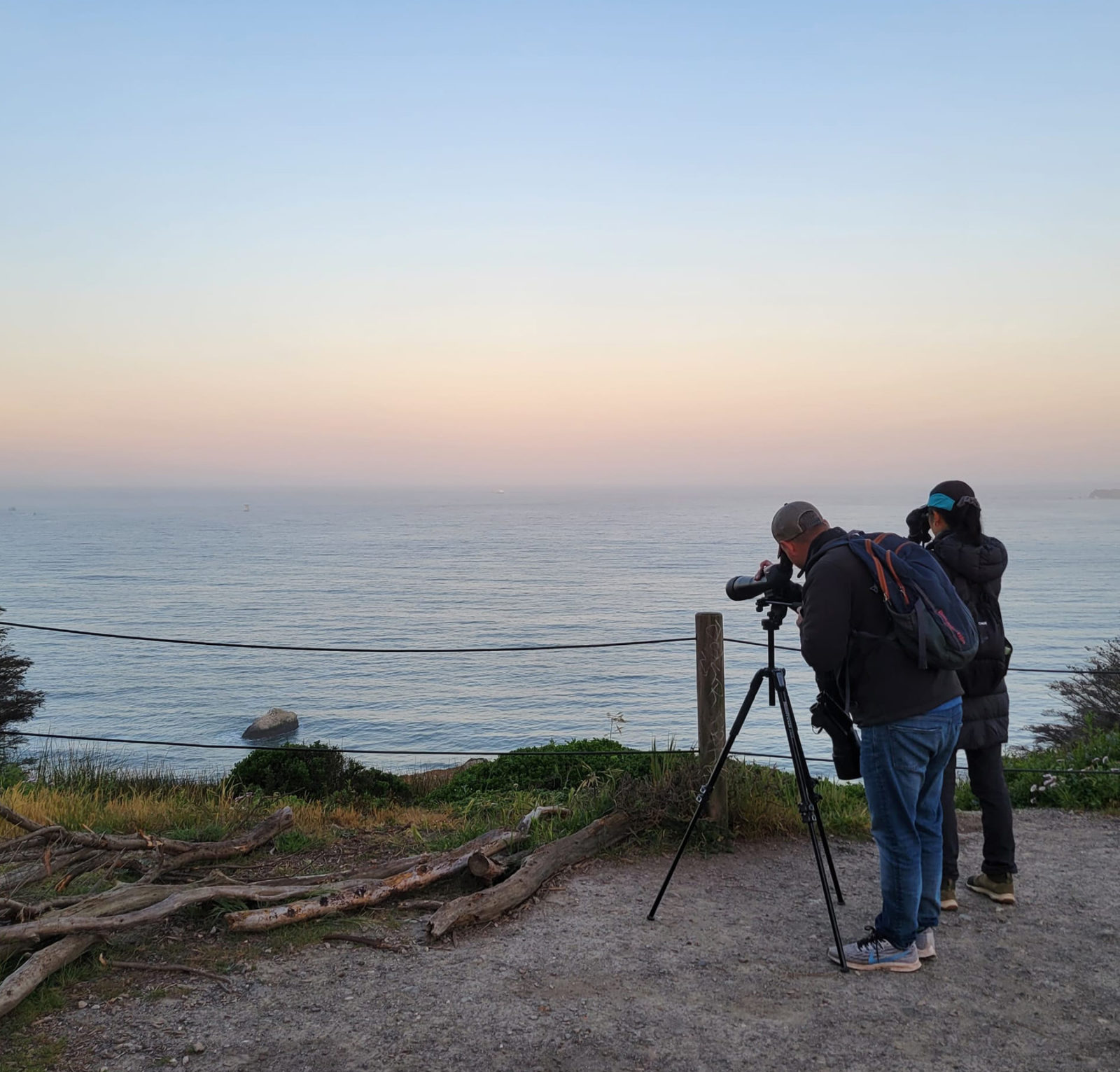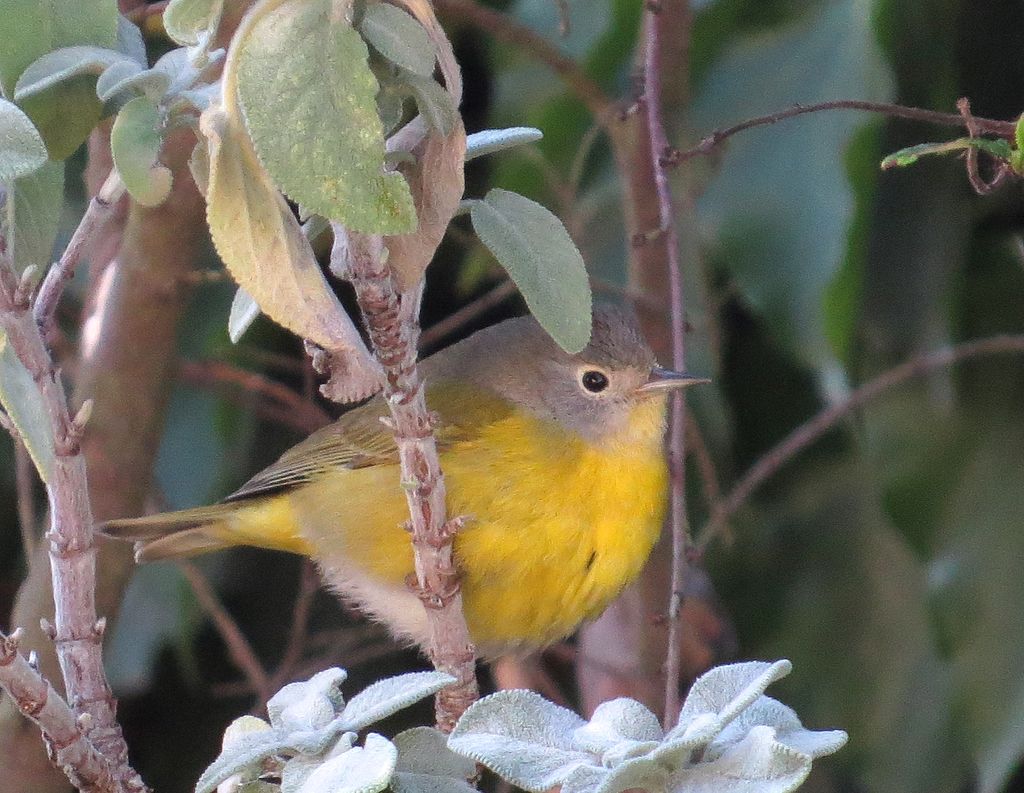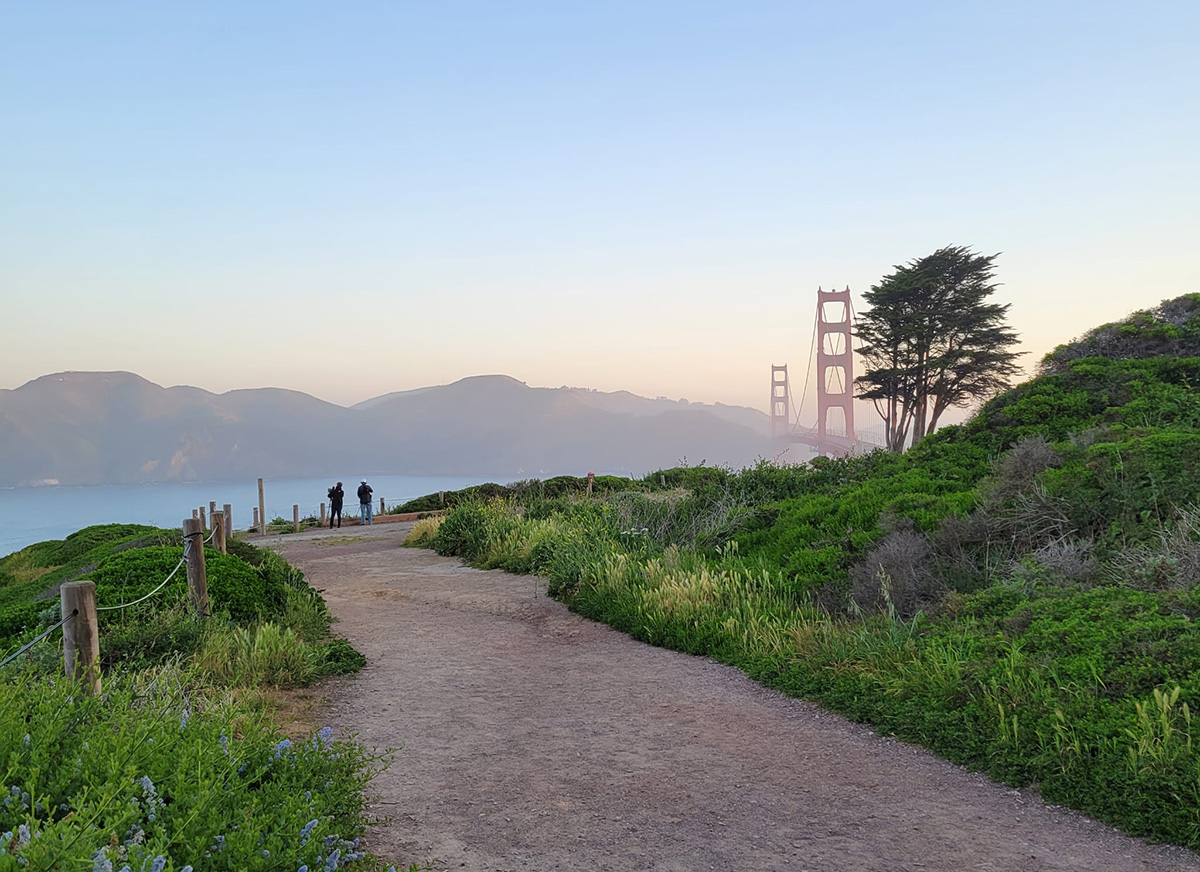Birders sometimes have competitions to see who can find the most bird species in a set amount of time. If you want to participate in one of these, a few things to know first: It is frenetic. It is competitive. Forget the leisurely walks through the woods; if you’re serious there isn’t even time for a lunch break.
It is, however, a great time to watch birders watching birds, and to try to understand the appeal of a pursuit that delights and entrances people around the world. So when two teams decided on a 13-hour competition this spring to see which side of the Bay could find the most birds, the debut Golden Gate Audubon Society Bay Birding Challenge, the two of us tagged along.
The leaders of the two teams, Alex Henry, Rachel Lawrence and Eric Schroeder of GGAS established ground rules in advance: teams could travel anywhere within their two assigned counties (San Francisco and San Mateo for the San Francisco team, and Contra Costa and Alameda for the East Bay team). Birds could be identified by sight or sound, but at least two people from the team had to see or hear them. The birding would begin at 6:14 a.m. exactly, 29 minutes before the sunrise, and end 13 hours later at 7:14 p.m.
1. Beginnings
Six fourteen a.m. rolls around without much fanfare in the mist at Lake Merced. It’s still dark at first light but bird identifications by sound fill the air around me: “ruddy duck,” “mallard,” “white-crowned sparrow.” As the sky lightens, gnats buzz below, and a double-breasted cormorant carrying nesting material flies above. San Francisco faces long odds in the competition – spring is a great time for birding in the East Bay – and the team starts here with the urgency of the underdog. “I don’t expect to win,” says San Francisco team leader Lawrence, “but I just don’t want to be embarrassed.”
After a 4 a.m. wakeup and a 40 minute drive from Berkeley, the East Bay team gathers in the darkness beneath Mount Diablo. It’s cold in Mitchell Canyon compared to Berkeley as the birders, decked out in hats, binoculars, walking sticks, spotting scopes, and hiking boots, materialize out of the darkness of the parking lot. The official start time marks an immediate end to our pre-dawn chatter.
The group moves slowly, on the lookout for the eye-glint of poorwills in the dim light and relying mostly on bird songs to identify the birds around us. Identifications ring out – “Steller’s jay,” “dark-eyed junco,” “orange-crowned warbler.” Someone yells out “flyover!” and everyone immediately turns to look at the sky as an oblong, feathered form flaps furiously overhead. It’s quickly identified as a band-tailed pigeon.

2. Conversations
We have walkie-talkies (Car 1 is Harpy Eagle, Car 2 is Mollymawk, a kind of albatross) to communicate during car rides. I hear things like, “Harpy Eagle, come in. This is Mollymawk.” “Did you see that? Over.” “The golden oriole has been acquired. Over.”
According to the itinerary, for our second stop we are to spend 25 minutes at Battery Godfrey in San Francisco’s northwest corner, where we are to be on the lookout for WREN, BEWR, SUSC SPTO PEFA and ELTE, all bird name abbreviations in a secret shorthand that everyone except me seems to know. (For the uninitiated, these are the American Ornithological Union’s official “alpha code” names for the wrentit, Bewick’s wren, surf scoter, spotted towhee, peregrine falcon, and elegant tern.)

As I struggle to differentiate between far off ocean birds through the scope, two of the latest arrivals to the birding group, Lisa Bach and Lisa Morehouse, assure me that it gets easier. And over the day it does, most likely because I’m out with six women, and they have taken me under their wing. Of the six, four tell me that birding has been an activity that has helped them move from stress to calm. Being outdoors looking for birds, they say, gives them an opportunity to look at their lives and environments in a new light.
It is hellishly windy as we look out over the bluffs. We check off whimbrels flying low over the surf. Then, as the list dictates, we get the SUSC, the PEFA, and the ELTE.
Mitchell Canyon is a birding hotspot, and the list of acronyms runs long. The birders hope particularly to check off the COPO (common poorwill) and WESO (western screech-owl) in the early morning. Both elude us, but we do find the SSHA (sharp-shinned hawk), the BGGN (blue-gray gnatcatcher) and 47 other species in the canyon alone.

“My day is complete!” jokes Anne Ardillo after seeing the blue-gray gnatcatcher, one of her favorite birds, at around 9 a.m. Ardillo started volunteering at the Golden Gate Raptor Observatory in 1993, after hearing about the opportunities there on the news. Working with raptors became an outlet for her as a stay-at-home mom, and turned into a lifelong pursuit. She’s now got a license from both state and federal governments to band raptors, and continues to volunteer for both GGRO and the Marin animal hospital WildCare.
“Being a scientist and loving the outdoors, the Golden Gate Raptor Observatory afforded me the opportunity to fill that gap or personal need to feel like a whole person,” Ardillo says.
3. The Nashville Warbler
Hundreds of cedar waxwings take to the air over the Fort Mason community garden. Their rapid flight creates a dizzying pattern against the blue of a pristine spring sky. By 8 a.m. it is turning into a perfect day in fog city, and the garden is a hotspot of avian and human activity. Fort Mason’s surroundings are a birding paradise — its liminality invites land and sea birds, migrants and vagrants. Ebird lists suggest that as many as 180 species can be spotted here. Today, a red-whiskered bulbul, a small black crested songbird introduced to California in the 60s and native to South Asia, has created a hullabaloo. Birders, binoculars pointed treeward, line the sidewalk for a look. The bulbul is rare for the Bay Area – they are common in Southern California but seem to be moving northward.
Noisy mockingbirds and red-masked parakeets make it hard to hear other birds. Dawn Lemoine, San Francisco’s oldest team member, has had eye surgery and birds largely by ear. She turns to the mockingbirds, exasperated, and says, “Oh hush now!” From the community garden we check off the warblers: orange-crowned, yellow-rumped and black-throated gray. But the birders seek in vain for a Nashville warbler, and are eventually forced to give up.
“Guys, there’s a Nashville warbler!”
The elusive bird has materialized in Mitchell Canyon, to the delight of the East Bay team.
“Shut the front door!” comes a reply.
It is a small, neat looking bird – a bright yellow throat contrasting with a gray head and back. Sometimes, even in the midst of a competition, a bird forces a pause. As competitive as the day is, with checklists and itineraries circulating, this is still ultimately an act of appreciation for the wonder of the natural world. As the bird hops around in a nearby bush, all ten of us stand motionless, taking a moment to appreciate it in the morning light.

It’s a process repeated even in the quick identifications. It starts with a cry: “what’s that?” Immediately everyone freezes, heads swivel in the direction of the sound. Ears open, eyes wide or sometimes closed as they focus on listening, and mouths left slightly ajar.
Binoculars rise in unison as conversations stop mid-sentence. The only words spoken are the occasional “where?!” and the possible names of the suspect trilling at us from dozens of meters away.
Someone identifies it as a varied thrush, but the bird moves on, too far away for confirmation.
4. Observations
A few hours in, as we stalk the oak woodlands of Golden Gate Park, a gambler mentality sets in. Play the odds, let the chips fall where they may. At times, there is a frantic air about the birders — sudden swerves and shouts puncture the warming air. And sometimes, there are wondrous pockets of silence as they look out in expectation over the water or stare up into the trees, united in a kind of grace.
Just when I’m starting to elevate their pursuit into something noble, two of the team members crash a wedding to add a barn owl to the list. Birders have a strict code against sharing owl nest locations, so no telling where this happens. But 14-year-old Eddie Monson, the youngest member of our group, walks into the venue as if he is part of the wedding party. Yvette MacDonald first follows him to add a second for documentation, then pretends that she is there to fish a wayward son out of the party.
Every single bird counts, even the ones from the car. As we ride in Schroeder’s Volvo up Spruce Street on the way to Tilden Regional Park, a fluttering form flies over the car.
“Is that a Eurasian collared dove?!”
Schroeder immediately slams on the brakes and pulls into a residential driveway. The birders hop out of the car, pause to check for traffic, and race across the street to look for the dove, binoculars at the ready. They’re out and running before I’m even unbuckled. By the time I make it over to them, the excitement is gone. It’s just a mourning dove, and we’ve already got one of those. We pile back into the car and drive toward Tilden, eyes and ears peeled as we cruise up the North Berkeley streets.

5. Highlights
The seagulls at Heron’s Head Park are completely beside themselves, screeching and fluttering, an indication that something unusual has spooked them into the air. And there it is: Monson runs down the path yelling “bald eagle, bald eagle!” The eagle is an unusual sighting for San Francisco. It glides by, majestic yet easy, leaving the ruckus in its wake.
MacDonald stops us at a resident Allen’s hummingbird in the Heron’s Head parking lot. Birding changes and yet doesn’t — seasons, tides, times of day come and go again, bringing constant change on predictable cycles. Birding offers steady friendship with a bird that is always there, the comfort and familiarity of a known quantity in a known place – and five minutes and a quarter-mile away, something unusual and exciting.
As the early evening stretches on, the time between new bird sightings has lengthened tremendously. We walk in a single file line near Jewel Lake, the shadows and shade deeping as we tread in silence and strain to listen.
The team wants to find nuthatches and great horned owls, both of which ultimately evade us, but we do finally see a brown creeper – a streaky brown bird known for skittering its way up the trunks of trees. The bird, identifiable by its hunched-over posture, decurved bill, and long tail, is a relatively common sight in the Bay, but it has taken us all day to find one. Sometimes what’s familiar and common still doesn’t show up – as is the nature of being in nature, no matter how hard we look or listen there’s a lot of chance and luck that goes into birding.
We continue our walk near Jewel Lake, silently hoping for just a few more birds to add to our list. Suddenly, we all heard a song that to my ear sounds like a robin – clear, evenly spaced syllables often characterized as cheerily, cheer up, cheer up, cheerily, cheer up – but two or three times faster. Someone in our group recognizes it instantly: a black headed grosbeak!
There is rejoicing. One team member jumps and ricochets off of a nearby tree trunk in excitement, and there are grins, cheers, and high-fives all around. We’ve been texting with the San Francisco team most of the day and the counts are nearly tied. It’s late, nearly 7 p.m., and many are feeling sweaty, sore and tired. The grosbeak gives us one last jolt of adrenaline as we head into the final minutes of the big day.
After time is called, our team gathers near Tilden’s Little Farm to go over the final tally. Henry reads out the final list, and then the day is done. A great horned owl hoots at us, a few minutes too late to be counted, as everyone heads back to their cars, content and exhausted, already talking about next year’s Bay Birding Challenge.
| Team San Francisco Itinerary | Team East Bay Itinerary |
| Lake Merced | Mitchell Canyon |
| Battery Godfrey | Miller/Knox Regional Shoreline |
| Crissy Field Lagoon | Sandpiper Spit |
| Fort Mason | Canal Blvd Viewing Platform |
| Lafayette Park | Vincent Park |
| Golden Gate Park | Meeker Slough |
| Stow Lake | Sea Breeze Market Cove |
| Middle Lake, North Lake | Berkeley Marina |
| Spreckels Lake | Point Emery |
| Ocean Beach | Emeryville Southern Seawall |
| Lands End | MLK Jr. Regional Shoreline |
| Heron’s Head | Arrowhead Marsh |
| Yosemite Slough | Lake Merritt |
| Colma Creek | Tilden Nature Area |
Endings
By the end of April, the Bay Birding Challenge raised over $15,000 to support the Golden Gate Audubon’s ongoing programs, which include restoring habitats for Bay Area birds, free birding trips to explore local habitats from Golden Gate Park to the East Bay shoreline and hills, running an incredible osprey cam, and birding classes.
And in a surprising turn of events, the underdogs triumph. The San Francisco team won with 146 individual species counted while East Bay closed out the day with 141.
The birds of the Bay were allowed a night’s respite before many of the participants set out again, some as early as 6.30 a.m. the next day – ears cocked, binoculars hanging from sunburned necks, eyes always seeking a flash of feathers.





